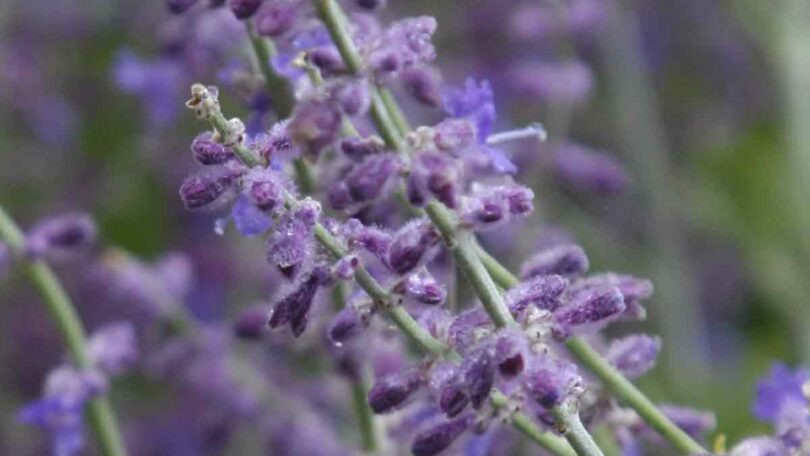A lavender alternative.

Pale blue to mauve flowers appearing on spikes with gray green foliage that is attractive through the season, (Perovskia atriplicifolia ) adds a mist of colour to the garden in summer to autumn. A few varieties are available including the popular ‘Little Spires’.
And although the common name is ‘Russian Sage’ this is a plant that is originally from Afghanistan.
How to Grow Russian Sage – Basic Care
We find this to be a drought tolerant hardy plant once established. It does require a sunny position and a well drained soil.
It grows well in warmer climates and performs best in full sun where flowering will be more prolific and growth generally stronger.
The best time to plant Russian sage is in early spring which gives it time to establish a good root system before the heat of summer.
- When planting, dig in some well rotted compost and aged manure first.
- Water in well with a liquid seaweed fertiliser.
- Mulch around the plant to help maintain a cool root run.
Fertilise lightly and mulch in spring each year. Be careful not to overwater and use fertiliser sparingly as this will promote lanky growth.
Can you grow Russian Sage in Containers?
Yes as long as the soil is well drained and the position is sunny it v=can make an excellent container plant in courtyard or on a patio.
Landscaping Uses
Used in the general garden border, Russian Sage (Perovskia atriplicifolia ) can also be used as a low hedge plant. In the garden space the plants at 1m to give them adequate room to take on a natural shape. As a hedging plant space them at .5m apart.
Excellent when used as a foil for ornamental grasses.
With foliage that gives off a perfume when crushed this is also a plant that is suited to use in a sensory garden. Also excellent for attracting bees to the garden.
This is a great plant to grow in cooler climates where lavender sometimes struggles.
Varieties
- Blue Spires – Silvery grey foliage with blue flowers to 60 cm.
- Little spires – Broader foliage, blue flowers.
Pruning
Remove or ‘deadhead’ spent flowers for a second flush of blooms.
Established plants can be cut back to 1/3 metre in autumn or winter. In spring once new growth commenced trim them back again to just above the new growth..
In warmer climates you could prune in winter, cutting the plants right back ground level and leave the pruning over the plant for some protection from frosts.
Or in colder climates wait until spring and then as soon as new growth appears cut back to just above that.
Both new and established plants can also be pruned in late spring. New plants can be cut back to shape when planting to eliminate any weak growth.
Propagation
It is an easy plant to propagate by dividing established clumps in spring as soon as new growth appears.
Companion plants
Echinacea, Helenium, Calamagrostis Karl Foerester, Phlox
Summary
- Plant Type – Perennial
- Flower Colour – Pale blue to mauve.
- Leaf – Mid gray green finely cut and aromatic when crushed.
- Height – 1m to 1.5m
- Spread – 1m
- Growth Rate – Medium to Fast.
- Soil – Humus rich well drained.
- Sun Shade – Best in full sun with a little light afternoon shade in warmer, drier areas.
- Climate – Temperate to Warm
- Water – Will require extra water only during very long dry periods.
- Coastal Suitability – Yes
- Frost Tolerance – Moderate
- Flowering Period – Summer to Autumn.
Where can you buy Russian Sage?
Russian sage is available for sale from the following participating nurseries.
Large variety of Epimediums, Woodland plants and Herbaceous perennials
Mail order or nursery. We do not send to Tasmania or WA
www.cloverhillrareplants.com
Little Hampton, Vic 345
"Mail order nursery specialising in cottage garden perennials, flowering shrubs, Trilliums, Hostas and Pacific Coast Iris. Flat rate express postage - Except WA & TAS"
www.botanicaltreasures.com
'Umbango' 750 Humula Rd, Humula NSW 2652
Phone 0408692773 Great Range of Perennial plants available for sale by mail order.
www.nutshellnursery.com.au
www.planterspatch.com.au
52 Rodd St Canowindra NSW 2804
An online nursery specialising in drought and frost tolerant perennials and fragrant, edible and herbs.
www.perennialle.com.au





